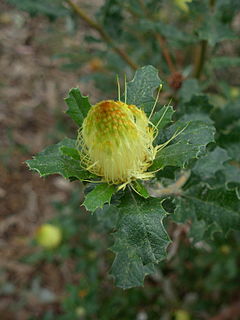
Banksia cynaroides is a species of shrub that is endemic to Western Australia. It has crowded, linear, pinnatifid leaves, white and dull golden yellow flowers and few follicles in each head.
Banksia epimicta is a species of prostrate shrub that is endemic to a small area in the south-west of Western Australia. It has crowded, sharply pointed pinnatifid leaves, large heads of unpleasantly scented, creamy white and pale yellow flowers and a small number of follicles.

Banksia erythrocephala is a species of prickly shrub that is endemic to Western Australia. It has erect stems, sharply pointed pinnatifid leaves, cream-coloured and reddish black or all cream-coloured and yellow flowers, and egg-shaped fruit.
Banksia foliolata is a species of shrub that is endemic to Western Australia. It has hairy stems, pinnatifid leaves, heads of about sixty cream-coloured and maroon flowers and oblong to elliptical follicles. It grows on rocky slopes in dense shrubland in the Stirling Range National Park.

Banksia hewardiana is a species of openly branched shrub that is endemic to Western Australia. It has linear, serrated leaves with sharply pointed teeth, head of up to sixty lemon-yellow flowers and oblong follicles.

Banksia horrida, commonly known as prickly dryandra, is a species of shrub that is endemic to Western Australia. It has hairy stems, linear, pinnatifid leaves with sharply pointed teeth on the edges, up to sixty cream-coloured flowers in each head and hairy, egg-shaped follicles.
Banksia idiogenes is a species of tufted shrub that is endemic to Western Australia. It has hairy stems, deeply pinnatifid leaves, distinctive, scented, red and white flowers in heads of about eighty, later several glabrous, egg-shaped follicles in each head.
Banksia ionthocarpa is a species of shrub that is endemic to Western Australia. It has short, hairy, prostrate stems, pinnatifid leaves, pinkish purple to orange flower in heads of between forty and sixty at the base of leaves, and egg-shaped follicles with a distinctive tuft of hairs on the end.

Banksia kippistiana is a species of shrub that is endemic to Western Australia. It has linear, pinnatifid leaves with ten to twenty lobes on each side, heads of up to eighty yellow and cream-coloured flowers, and elliptical follicles.
Banksia lepidorhiza is a species of prostrate shrub that is endemic to Western Australia. It has underground stems, linear pinnatipartite leaves with sharply pointed lobes, pink, cream-coloured and yellow flowers in head of about thirty and egg-shaped follicles. It is only known from near Woodanilling.

Banksia obtusa, commonly known as shining honeypot, is a species of shrub that is endemic to the south-west of Western Australia. It has underground stems, linear pinnatifid leaves with triangular lobes on each side, cream-coloured to yellow flowers in heads of up to seventy, surrounded by dark reddish bracts and egg-shaped follicles.
Banksia pallida is a species of column-shaped shrub that is endemic to the south-west of Western Australia. It has densely hairy stems, linear leaves with three to five serrations on each side, pale yellow flowers in heads of up to eighty and egg-shaped to elliptical follicles.

Banksia polycephala, commonly known as many-headed dryandra, is a species of bushy shrub that is endemic to Western Australia. It has linear, pinnatisect leaves with up to twenty-five triangular lobes on each side, small, creamy yellow flowers in heads of up to seventy and egg-shaped follicles.

Banksia undata, commonly known as urchin dryandra, is a species of shrub that is endemic to the southwest of Western Australia. It has sessile, wedge-shaped, wavy, serrated leaves, pale yellow flowers in heads of between 80 and 160, and later up to eight follicles in each head.

Banksia purdieana is a species of bushy shrub that is endemic to Western Australia. It has broadly linear, pinnatipartite leaves with sharply-pointed lobes on the sides, yellow flowers in heads of about eighty and egg-shaped follicles.
Banksia rufistylis is a species of column-shaped shrub that is endemic to Western Australia. It has linear leaves with sharply-pointed serrations, cream-coloured flowers with a red style arranged in heads of about forty, and egg-shaped follicles with a flattened tip.

Banksia sclerophylla is a species of shrub that is endemic to the south-west of Western Australia. It has spreading stems, linear, pinnatipid leaves with triangular lobes on the sides, yellow flowers in heads of between forty and seventy, and elliptical follicles.
Banksia shanklandiorum is a species of dense shrub that is endemic to Western Australia. It has hairy stems, pinnatipartite to pinnatisect leaves with sharply-pointed lobes, pink to gold-coloured flowers in heads of about 100, and egg-shaped follicles.

Banksia subpinnatifida is a species of bushy shrub that is endemic to the southwest of Western Australia. It has more or less linear, pinnatipartite leaves with sharply-pointed teeth on the sides, golden yellow flowers in heads of about sixty, and glabrous, elliptical follicles.

Banksia tenuis is a species of shrub that is endemic to the southwest of Western Australia. It has pinnatifid, serrated or smooth-edges leaves, golden brown and cream-coloured flowers in heads of about fifty-five and glabrous, egg-shaped follicles.












